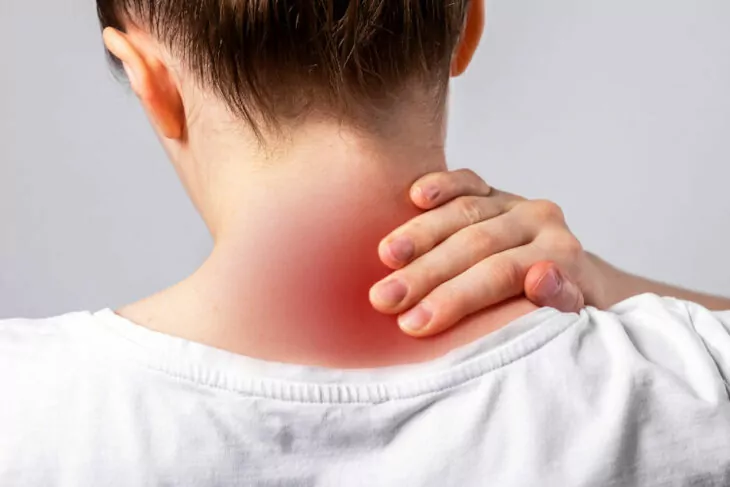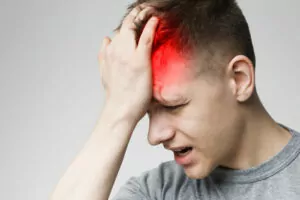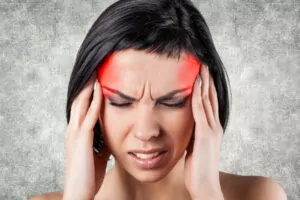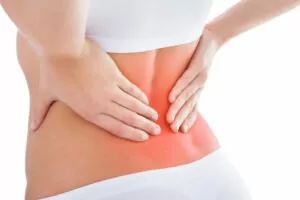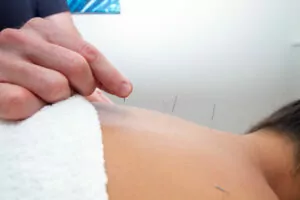Neck pain is a highly common issue that can cause several different problems for suffers. Studies show that most of us will suffer from neck pain at some stage in our lives. Neck pain can range from a few minutes to months or even be ongoing for years.
Now, I get what you’re thinking – that neck pain is just neck pain, right? The thing is neck pain can cause so many other issues such as:
- Nausea
- Dizziness
- Weakness
- Pins and needles or numbness sensations
- Problems concentrating
- Vision or hearing impairment
- Difficulty swallowing.
- More commonly than not, headaches or migraines can largely be attributed to chronic neck pain.
Brad, a frequent visitor to our practice, had been experiencing chronic neck pain prior to seeing us. He would attempt to relieve the pain with heat/ice packs, stretches, hot showers and various medications. Although Brad experienced short-lived results, the pain would come back within a couple of days to sometimes in just a couple of minutes.
Brad FINALLY got the help he needed after we were able to diagnose exactly what was causing his neck pain. We were then able to alleviate this pain for Brad and give him advice on how to stop this from occurring in the future.
I’m sure you’re curious to know more about neck pain, so keep reading because I am going to cover something VERY important. I’m about to help you understand more about YOUR neck pain, as well as possible solutions for YOU.
Understanding YOUR Neck Pain
As mentioned, neck pain is a highly common occurrence. However, if you were to ask different people about their experience with neck pain, and how they are suffering from it, the pain they describe will be quite different. This is unfortunately the reality of neck pain. It can manifest itself into numerous different conditions for different people even when the way it presents itself to us is the same- its neck pain!
Nevertheless, by being able to clearly recognise and describe the symptoms of what you experience with your neck pain, you will be able to improve your chances of complete recovery from neck pain.
The following are just some of what YOU may be experiencing:
- Sharp pain – a “stabbing” sensation or may feel sharp in a localised area of the neck
- Pain on movement – this is when the pain becomes exacerbated by twisting, moving, or an extension of the neck, either to one side or the other and/or up and downward movements.
- Stiff neck – a “stuck’ or “stiff” feeling of the neck with decreased mobility and range of motion.
- Pain that refers or causes numbness – pain which radiates around the body, either to the trunk, head, shoulder/s or arms. When neck pain involves compression of a nerve, this can bring on feelings of tingling, numbness, or a sharp/burning sensation. The pain can even cause weakness in either the hands or arms.
- Pain upon touch – neck pain will increase when the neck is touched with any kind of pressure, or physically examined.
What is Causing YOUR Neck Pain?
There are a vast number of reasons why you may be experiencing neck pain. Neck pain will often appear due to the following:
- Muscular strain
- Compression of nerves
- Joint degeneration – of the facet joints, which are located at each vertebra on each side of the spine, and assist the spine with movement.
- Disc degeneration – such as bulging or herniated discs
- Complex medical issues- like rheumatoid arthritis or autoimmune diseases
Are Your Muscles Leading to Neck Pain?
The neck contains various muscles, which all work together to help hold the weight of the head. When these muscles become overworked or strained, the muscle can become inflamed, injured, or irritated. Neck tension will cause pain in the neck when the neck muscles lose the ability to relax which may cause general soreness, spasming, or develop into headaches and migraines.
Muscles that may be associated with your neck pain include the muscles shown below:
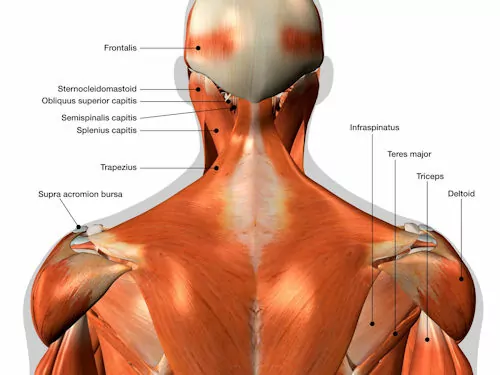
Sternocleidomastoid (SCM) Syndrome
The sternocleidomastoid, or SCM in short, are two muscles that can be visibly seen at the front of either side of the neck, and assist with neck and head movement. The muscle assists with the rotation of the head to the opposing side and helps rotate the head diagonally. The SCM muscle will also aid with flexion of the neck. The SCM when tight, can cause tension throughout the entire head of an individual, which in turn, can cause mild or severe headaches.
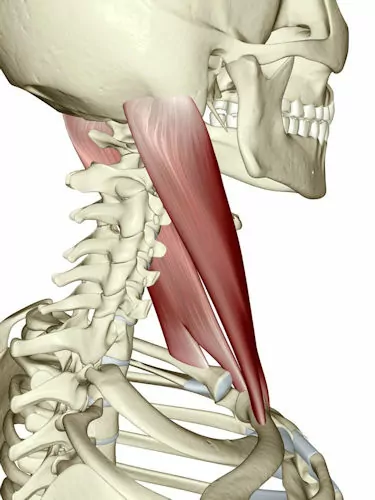
There are two attachment points of this muscle: the sternal division (attaching at the sternum) and the clavicle division (attaching at the collar bone). Each division has distinct and separate referred patterns of pain.
The clavicular division is felt more in the forehead, behind the ear or deep within the ear, and around the molar teeth. The pain in the forehead can be felt across the midline of the forehead or toward one or both sides of the forehead.
The sternal division is felt within the eye socket, or behind and above the eye, around the check, the upper chest, on the top or back of the head, and can also bring pain to the jaw or the temporomandibular joint (TMJ for short)
Causes of SCM Syndrome
There are many reasons as to why this is bought on. In our clinic, we typically see a combination of factors causing SCM Syndrome.
The following is a list of reasons why this may occur:
- Poor posture including a forward head position
- Pillow height – either too high or too low
- Excessive Driving
- Sport – trauma associated with sporting injuries
- Whiplash
- Occupation – Sitting in front of a computer for an excessive amount of time
- Illness such as chronic coughing
Additional Symptoms of SCM Syndrome
It is also not uncommon for the following symptoms to occur:
- • reddening of the eyes
- • frequent head tension or headaches
- • sinus issues or a sore throat
- • balance problems and even dizziness
Suboccipital Muscle Group
The suboccipital muscles are a group of four muscles, which are located below the occipital bone (back-base of the skull). The four muscles include the obliques capitis inferior, obliques capitis superior, rectus capitis posterior major, and rectus capitis posterior minor.
When these muscles are overstimulated and begin to spasm, they may entrap nerves that travel through this region, thereby compressing the nerve which set off a domino effect which can lead to either a migraine or tension headache.
Is Cervical Osteoarthritis the Cause?
Cervical osteoarthritis, also known by the term cervical spondylosis, is a condition that involves changes in the disc, bones and joints located in the neck. Typically, these changes will be due to the aging process or general “wear & tear”. Aging can often lead to a gradual loss of fluid, which can reduce the fluid within our discs, and make the neck (cervical) become more rigid.
Symptoms associated with Cervical Osteoarthritis include:
- Neck pain and stiffness
- Migraines or headaches originating from the neck
- Pain in the arms or shoulders
- Limited range of motion when trying to bend or turn the neck
- A grinding sensation when turning the neck

Is a Pinched Nerve the Culprit?
A “Pinched nerve” clinically known as cervical radiculopathy, happens when one or numerous nerves in the neck become irritated and/or compressed. The sensation felt may be radiating pain, which means the pain can be starting from the neck, but then it will travel to either the shoulder, arm or even as far as the fingertips. This can also cause numbness and/or weakness in the arms or shoulders.
There are a bundle of nerves that come from the neck. This system of nerves are referred to as the brachial plexus. This network of nerves will send signals from the spinal cord (the neck region) to the hands, arms, and shoulders. This communication is what helps us move these body parts. Injury to the neck can lead to these nerves becoming compressed or stretched, and in worst-case scenarios being torn or ripped from the spinal cord.
The severity of symptoms can vary greatly.
Less severe symptoms may be present for minutes or just a few seconds, however, can linger for longer periods. These symptoms may include:
- Burning or electric shock sensation travelling down the arm
- Weakness or numbness in the shoulder or arm
Highly severe symptoms are more common when there is an injury present that impact the nerves, either by a rupture or tear. These include:
- Severe pain
- Inability or weakness when attempting to move your hands, shoulder, or arm
- Complete lack of feeling or range of motion in the shoulder, hand, or arm
Occipital Neuralgia
Like a headache, Occipital Neuralgia has a precise origin which is often different to a regular migraine or headache. Occipital neuralgia is due to injury, inflammation, or irritation of the occipital nerves. These nerves run from the base of the neck through to the back of the skull.
Occipital neuralgia is most commonly isolated trauma to the neck. Other causes include things like arthritis, tight muscles of the neck or diabetes.
Pain associated with occipital neuralgia is characterized by a throbbing sensation, piercing pain, and a feeling of shock-like pain in either the upper neck, behind the ears, one side of the head or concentrated at the back of the head. Commonly, the pain will start from the base of the neck and spread upward over time.
Is Your Neck Pain from a Bulging Disc or Dehydration?
The colloquial term “disc” gives reference to its proper name “intervertebral disc”. The “disc” itself is a spongy cushion that helps with shock absorption, aids in pivoting movements, and helps stabilize the overall spine. It is located between the bones of the spine (vertebrae).
Disc Bulge or Herniation
As mentioned above, dehydration and other factors can lead to changes in the outer layer of the disc which may result in weakness, causing the disc to bulge outward. Bulging disc won’t always impact the entire disc. It is most common for just a quarter of the disc to be affected. With a bulging disc, only the outer layer of the disc is involved.
On the other hand, a herniation of the disc is due to a thin crack in the outer layer, which leads to the inner area leaking out through the outer layer of the disc. When this occurs, it is only a small portion of the disc that is impacted.

Dehydration
Dehydration can have a large impact on both neck pain and back pain, as water consumption and retention effects the fluid held within the discs in the spine. Water is an essential component for most bodily functions, energy levels and our metabolism. Dehydration also has a negative impact on the body’s tissues and organs. The human spine holds a large amount of water, and lack of water leads to an impact on the spine’s range of motion and overall health.
When the disc goes through wear and tear, the disc begins to lose fluid and this water loss will cause the disc to begin to thin, therefore resulting in a change in the tissue density. Bending, running, and jumping movements will all have an impact on the level of fluid in the disc, due to the movement of the disc. These high-impact movements cause discs to begin to lose fluid. Pressure on the discs from everyday activities, as well as gravity in general, place excessive weight on the disc, which reduces the amount of fluid contained in the disc themselves. This, over time, results in a loss of disc height and durability.
Natural Therapies for Neck Pain
As with all situations, I always recommend starting with the most non-invasive treatment options first. Pain, whether it be acute or chronic can be effectively treated with Natural Therapies like Acupuncture, TENS Therapy, Electro-Acupuncture, Remedial Massage, Cupping Therapy, Trigger Point Therapy, Laser Therapy and Auriculotherapy.

Ready to Give Neck Pain the Old Heave-Ho?
The most important thing about getting much-needed relief from neck pain is to apply an effective strategy. Results may be short-lived if failing to do so, with symptoms becoming more persistent as time goes by.
When it comes to developing an effective recovery plan, it’s paramount to see a therapist like an Acupuncturist that is skilled in:
- Performing key physical assessment techniques to diagnose exactly what type of neck pain you are experiencing and why this has developed (causes may vary significantly!!!)
- Applying best practice treatment protocols that get results fast and provide ongoing relief
- Understanding WHY you developed this pain and implementing lifestyle advice to help prevent this condition from ever coming back again.
If you are looking for assistance with neck pain, please call our friendly team on (02) 4709 6727 to learn more about how we can help, or simply book online now to secure an appointment time so we can help get you started!

